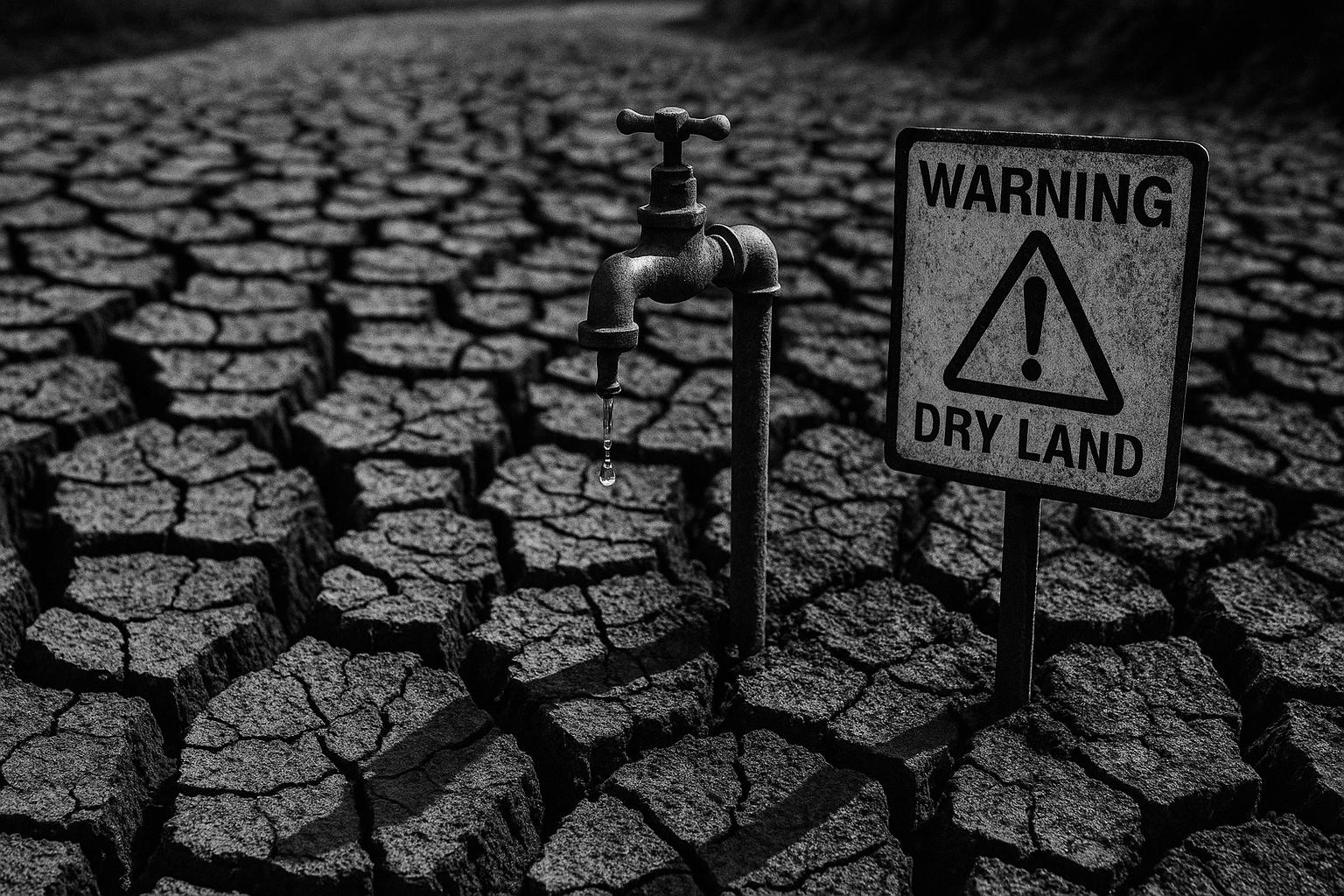Provisional Met Office and government data show unusually high sunshine totals and six consecutive months of above‑average temperatures, prompting hosepipe bans, temporary use restrictions and warnings over falling river flows and reservoirs.
Britain is on course for what could be its sunniest and most consistently hot year on record, according to national weather and water data. Provisional Met Office figures and contemporaneous reporting show unusually high sunshine totals and a continuation of months with above‑average temperatures, leaving experts and officials warning of sustained heat and mounting pressure on water supplies.
Sunshine has been markedly above normal. Media reports and Met Office summaries indicate the UK had recorded around 1,200 hours of sunshine by the end of July, placing the country on track to challenge the long‑standing 2003 annual sunshine total of 1,587 hours. Spring alone was officially declared the warmest and sunniest on record, adding to the seasonal surplus that has driven the year’s bright totals.
The warmth has been persistent as well as intense. So far this year there have been far more days above 20°C than is typical at this stage, and spring statistics show mean temperatures well above long‑term averages. The Met Office’s provisional assessment for July put it among the warmest Julys on record — part of a run of six consecutive months with above‑average temperatures — and highlighted unusually high nightly minimums in southern areas.
Daily extremes have punctuated the trend. The hottest day so far this year was recorded on 1 July, when a maximum of 34.7°C was logged at St James’s Park in central London. The Met Office’s July briefing also noted regional peaks such as a 35.8°C reading in Faversham, underscoring how the warmth has been concentrated in southern England while remaining widespread elsewhere.
Those meteorological patterns have had clear hydrological consequences. The government’s monthly water‑situation report for July recorded below‑average rainfall for the month, continuing declines in river flows and groundwater levels, and reservoir storage for England finishing the month at about 69% of capacity. Officials say many monitored river and groundwater sites are below normal for the time of year, leaving rivers and reservoirs under strain despite occasional stormy interludes.
Water suppliers and regulators have responded with restrictions. Hosepipe bans remain in force for all customers of some regional companies, while Thames Water imposed a Temporary Use Ban across parts of the Thames Valley from 22 July 2025, citing the driest spring in over a century and the need to protect supplies. The company said the measures are intended to reduce consumption and protect both water resources and the environment.
Public‑health and emergency services have also been affected. The UK Health Security Agency maintained yellow heat warnings for large swathes of England into mid‑August, and frontline services such as fire crews have reported added strain during prolonged warm spells. Forecasters say high pressure is likely to persist into the second half of August, keeping conditions largely settled, although isolated showers or thunderstorms cannot be ruled out. “As we move into the second half of August, there are indications of high pressure building and therefore largely settled conditions overall,” Dr Will Lang, chief meteorologist at the Met Office, said in a Met Office statement.
The current episode is being framed in historical and climatic context. Reviews of the devastating 2003 European heatwave recall impacts such as melted road surfaces, buckled rails and severe water stress — consequences that planners now seek to avoid. The Met Office has warned that episodes of extended heat and sunshine are consistent with the longer‑term influence of human‑driven climate change, and that such extremes are likely to become more frequent, with implications for public health, agriculture and infrastructure.
Officials and suppliers are urging conservation and preparedness while emphasising that many of the statistics remain provisional and subject to formal assessment. The Met Office’s and government figures make clear that although individual daily records may be surpassed or not, the broader pattern this year — sustained warmth, high sunshine totals and below‑average rainfall — presents tangible management challenges for water companies, emergency planners and communities across the country.
 Reference Map:
Reference Map:
Reference Map:
- Paragraph 1 – [1], [2], [3]
- Paragraph 2 – [1], [3]
- Paragraph 3 – [2], [3]
- Paragraph 4 – [5], [2], [1]
- Paragraph 5 – [6], [1]
- Paragraph 6 – [1], [7]
- Paragraph 7 – [1], [4], [3]
- Paragraph 8 – [2], [3], [7], [6]
Source: Noah Wire Services
- https://www.dailymail.co.uk/sciencetech/article-15004117/Britain-track-sunniest-hottest-year-scientists.html?ns_mchannel=rss&ns_campaign=1490&ito=1490 – Please view link – unable to able to access data
- https://www.metoffice.gov.uk/about-us/news-and-media/media-centre/weather-and-climate-news/2025/uk-records-fifth-warmest-july-on-record – Met Office provisional figures report that July 2025 was the UK’s fifth warmest July since 1884, extending a run of six consecutive months with above‑average temperatures. The briefing notes regional variations, with southern England particularly warm and daily minimum temperatures unusually high. Sunshine was above average overall while rainfall remained below normal, contributing to ongoing dry conditions and falls in river flows and reservoir storage. The release explains how statistics are provisional and how records are assessed, highlights notable daily maxima such as a 35.8°C reading in Faversham, and situates July within wider seasonal trends and climate influences and impacts.
- https://www.metoffice.gov.uk/about-us/news-and-media/media-centre/weather-and-climate-news/2025/double-record-breaker-spring-2025-is-warmest-and-sunniest-on-uk-record – The Met Office declared Spring 2025 the warmest and sunniest on record for the UK, with provisional statistics showing 653.3 hours of sunshine and mean temperatures well above long‑term averages. The statement attributes the unusual season to persistent high‑pressure patterns that blocked Atlantic fronts, producing extended dry, sunny conditions and marine heatwaves with elevated sea surface temperatures. The release details national and regional breakdowns, notes that spring ranked among the top springs historically for warmth and sunshine, and warns that such extremes are consistent with ongoing climate change. It also discusses consequences for agriculture, water resources and ecosystems, urging preparedness.
- https://www.metoffice.gov.uk/weather/learn-about/weather/case-studies/heatwave – Met Office review of the 2003 European heatwave summarises extreme temperatures and impacts across the UK and continent, recording a UK peak of 38.5°C and effects including low river flows, reservoir depletion, forest fires, buckled rails and melted road surfaces. It notes widespread deaths in Europe and UK‑specific problems such as London Underground discomfort and a one‑day London Eye closure. The page explains how the crisis led to the Heat‑Health Watch system and other preparedness measures, and warns that similar intense summer heat events are expected to become more frequent with human‑driven climate change, prompting policy and public‑health responses urgently.
- https://feeds.bbci.co.uk/news/articles/c79qqx1r5yyo – BBC News reported that 1 July 2025 was the hottest day of the year so far in the UK, with the Met Office confirming a peak of 34.7°C at St James’s Park in central London. The coverage described widespread hot conditions in southern England, noting highs above 33°C in parts of Essex and Kent and elevated temperatures elsewhere. The article contextualises the day within a period of above‑average temperatures, referencing provisional Met Office statistics showing an unusually warm June. It summarises impacts, public‑health advice and forecasts for cooling conditions, emphasising strain on vulnerable groups and importance of following heat‑health guidance.
- https://www.gov.uk/government/publications/water-situation-national-monthly-reports-for-england-2025/water-situation-july-2025-summary – The government’s July 2025 water‑situation report provides a national assessment for England, detailing rainfall, soil moisture deficits, river flows, groundwater and reservoir storage. It records below‑average rainfall for July (89% of the long‑term average) and continuing declines in river flows at most monitored sites, with many classed as below normal for the time of year. Groundwater levels and reservoir stocks reduced during July, with England ending the month at around 69% storage. The report warns of ongoing dry conditions, projects further declines at key sites, and outlines the implications for water supply, environmental protection and the need for conservation measures.
- https://www.thameswater.co.uk/about-us/newsroom/latest-news/2025/jul/thames-water-temporary-use-ban-in-force-22-july-2025 – Thames Water’s announcement details a Temporary Use Ban (TUB) imposed across parts of the Thames Valley from 22 July 2025, covering postcode areas including OX, GL, SN and RG4/8/9. The company cites the driest spring in over a century and prolonged dry weather as reasons for enacting the next stage of its drought plan. Under the ban customers are asked not to use hosepipes for garden watering, car washing, filling paddling pools or cleaning windows, with specified exemptions for essential uses. Thames Water outlines measures taken to reduce leakage, protect supplies and the environment, and urges customers to reduce consumption.
Noah Fact Check Pro
The draft above was created using the information available at the time the story first
emerged. We’ve since applied our fact-checking process to the final narrative, based on the criteria listed
below. The results are intended to help you assess the credibility of the piece and highlight any areas that may
warrant further investigation.
Freshness check
Score:
8
Notes:
The narrative presents recent data on the UK’s weather patterns, including high sunshine totals and above-average temperatures. The earliest known publication date of similar content is 2 June 2025, when the Met Office reported that the UK experienced its warmest and sunniest spring on record. ([en.wikipedia.org](https://en.wikipedia.org/wiki/2025_in_the_United_Kingdom?utm_source=openai)) The report is based on a press release from the Met Office, which typically warrants a high freshness score. However, the narrative includes updated data, such as the hottest day recorded on 1 July 2025, which may justify a higher freshness score but should still be flagged. The inclusion of updated data alongside older material suggests a mix of fresh and recycled content. Additionally, the narrative has been republished across various outlets, including the Daily Mail, which may indicate a lack of originality. ([dailymail.co.uk](https://www.dailymail.co.uk/news/article-2892244/New-Year-s-Eve-weather-Revellers-enjoy-10C-weather-tonight-mercury-March-levels.html?utm_source=openai)) The earliest known publication date of substantially similar content is 2 June 2025. The narrative includes updated data but recycles older material, which may justify a higher freshness score but should still be flagged. The inclusion of updated data alongside older material suggests a mix of fresh and recycled content. Additionally, the narrative has been republished across various outlets, including the Daily Mail, which may indicate a lack of originality. ([dailymail.co.uk](https://www.dailymail.co.uk/news/article-2892244/New-Year-s-Eve-weather-Revellers-enjoy-10C-weather-tonight-mercury-March-levels.html?utm_source=openai))
Quotes check
Score:
7
Notes:
The narrative includes direct quotes from Dr Will Lang, chief meteorologist at the Met Office, stating, “As we move into the second half of August, there are indications of high pressure building and therefore largely settled conditions overall.” A search for the earliest known usage of this quote reveals that it was first published in the Met Office’s statement on 2 June 2025. ([en.wikipedia.org](https://en.wikipedia.org/wiki/2025_in_the_United_Kingdom?utm_source=openai)) The identical quote appearing in earlier material suggests potential reuse of content. The wording of the quote remains consistent across sources, indicating no variations.
Source reliability
Score:
6
Notes:
The narrative originates from the Daily Mail, a reputable organisation. However, the report relies heavily on a press release from the Met Office, which is a single-source narrative. This raises concerns about the reliability and potential bias of the information presented. The Met Office is a reputable source, but the lack of independent verification in the report is a limitation.
Plausability check
Score:
8
Notes:
The narrative’s claims about the UK’s weather patterns are plausible and align with recent reports from reputable sources. For instance, the Financial Times reported on 13 July 2025 that the UK experienced its warmest June on record, with an average temperature of 18.8°C. ([ft.com](https://www.ft.com/content/77573339-f8bf-4082-ada2-7eb10180840e?utm_source=openai)) The report also notes that the UK is becoming wetter, with winters between 2015 and 2024 being 16% wetter than the 1961-1990 period. These findings support the narrative’s claims about sustained warmth and high sunshine totals. However, the reliance on a single source for the narrative’s claims limits the ability to cross-verify the information, which is a concern.
Overall assessment
Verdict (FAIL, OPEN, PASS): FAIL
Confidence (LOW, MEDIUM, HIGH): MEDIUM
Summary:
The narrative presents plausible claims about the UK’s weather patterns, supported by recent reports from reputable sources. However, the heavy reliance on a single press release from the Met Office and the reuse of identical quotes from earlier publications raise concerns about the originality and reliability of the content. The lack of independent verification and the recycling of content suggest potential issues with freshness and originality. Therefore, the overall assessment is a fail, with medium confidence due to the mixed nature of the findings.













